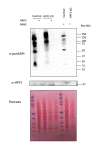Serine is the major residue for ADP-ribosylation upon DNA damage
- PMID: 29480802
- PMCID: PMC5837557
- DOI: 10.7554/eLife.34334
Serine is the major residue for ADP-ribosylation upon DNA damage
Abstract
Poly(ADP-ribose) polymerases (PARPs) are a family of enzymes that synthesise ADP-ribosylation (ADPr), a reversible modification of proteins that regulates many different cellular processes. Several mammalian PARPs are known to regulate the DNA damage response, but it is not clear which amino acids in proteins are the primary ADPr targets. Previously, we reported that ARH3 reverses the newly discovered type of ADPr (ADPr on serine residues; Ser-ADPr) and developed tools to analyse this modification (Fontana et al., 2017). Here, we show that Ser-ADPr represents the major fraction of ADPr synthesised after DNA damage in mammalian cells and that globally Ser-ADPr is dependent on HPF1, PARP1 and ARH3. In the absence of HPF1, glutamate/aspartate becomes the main target residues for ADPr. Furthermore, we describe a method for site-specific validation of serine ADP-ribosylated substrates in cells. Our study establishes serine as the primary form of ADPr in DNA damage signalling.
Keywords: ADP-ribosylation; ARH3; DNA damage; DNA repair; PARP; biochemistry; chemical biology; enzyme; human.
© 2018, Palazzo et al.
Conflict of interest statement
LP, OL, EP, HD, IM, IA No competing interests declared
Figures





Similar articles
-
Serine ADP-ribosylation reversal by the hydrolase ARH3.Elife. 2017 Jun 26;6:e28533. doi: 10.7554/eLife.28533. Elife. 2017. PMID: 28650317 Free PMC article.
-
An HPF1/PARP1-Based Chemical Biology Strategy for Exploring ADP-Ribosylation.Cell. 2020 Nov 12;183(4):1086-1102.e23. doi: 10.1016/j.cell.2020.09.055. Cell. 2020. PMID: 33186521
-
Serine-linked PARP1 auto-modification controls PARP inhibitor response.Nat Commun. 2021 Jul 1;12(1):4055. doi: 10.1038/s41467-021-24361-9. Nat Commun. 2021. PMID: 34210965 Free PMC article.
-
The fast-growing business of Serine ADP-ribosylation.DNA Repair (Amst). 2022 Oct;118:103382. doi: 10.1016/j.dnarep.2022.103382. Epub 2022 Jul 29. DNA Repair (Amst). 2022. PMID: 35963141 Review.
-
Functional Role of ADP-Ribosyl-Acceptor Hydrolase 3 in poly(ADP-Ribose) Polymerase-1 Response to Oxidative Stress.Curr Protein Pept Sci. 2016;17(7):633-640. doi: 10.2174/1389203717666160419144603. Curr Protein Pept Sci. 2016. PMID: 27090906 Free PMC article. Review.
Cited by
-
ADP-Ribosylation Post-Translational Modification: An Overview with a Focus on RNA Biology and New Pharmacological Perspectives.Biomolecules. 2022 Mar 13;12(3):443. doi: 10.3390/biom12030443. Biomolecules. 2022. PMID: 35327636 Free PMC article. Review.
-
Structural and biochemical evidence supporting poly ADP-ribosylation in the bacterium Deinococcus radiodurans.Nat Commun. 2019 Apr 2;10(1):1491. doi: 10.1038/s41467-019-09153-6. Nat Commun. 2019. PMID: 30940816 Free PMC article.
-
PARP14 is regulated by the PARP9/DTX3L complex and promotes interferon γ-induced ADP-ribosylation.EMBO J. 2024 Jul;43(14):2908-2928. doi: 10.1038/s44318-024-00125-1. Epub 2024 Jun 4. EMBO J. 2024. PMID: 38834852 Free PMC article.
-
HPF1 remodels the active site of PARP1 to enable the serine ADP-ribosylation of histones.Nat Commun. 2021 Feb 15;12(1):1028. doi: 10.1038/s41467-021-21302-4. Nat Commun. 2021. PMID: 33589610 Free PMC article.
-
CARM1 regulates replication fork speed and stress response by stimulating PARP1.Mol Cell. 2021 Feb 18;81(4):784-800.e8. doi: 10.1016/j.molcel.2020.12.010. Epub 2021 Jan 6. Mol Cell. 2021. PMID: 33412112 Free PMC article.
References
-
- Bilan V, Leutert M, Nanni P, Panse C, Hottiger MO. Combining higher-energy collision dissociation and electron-transfer/higher-energy collision dissociation fragmentation in a product-dependent manner confidently assigns proteomewide ADP-ribose acceptor sites. Analytical Chemistry. 2017;89:1523–1530. doi: 10.1021/acs.analchem.6b03365. - DOI - PubMed
Publication types
MeSH terms
Substances
Grants and funding
LinkOut - more resources
Full Text Sources
Other Literature Sources
Molecular Biology Databases
Miscellaneous

